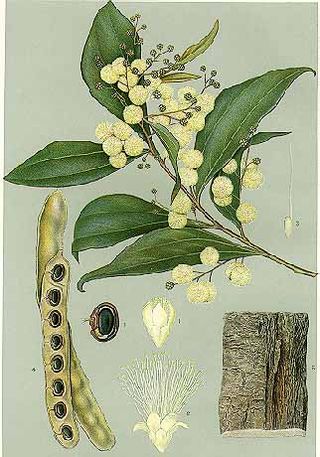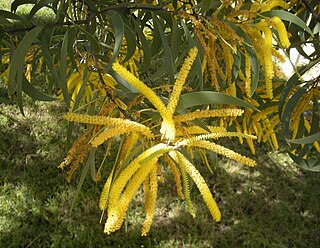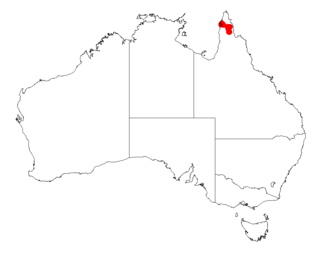
Acacia binervata, commonly known as two-veined hickory, is a shrub or tree that is endemic to eastern Australia.

Acacia hispidula, known colloquially as little harsh acacia, rough-leaved acacia or rough hairy wattle, is a species of Acacia native to eastern Australia.

Acacia drepanocarpa is a shrub belonging to the genus Acacia and the subgenus Juliflorae native to northern Australia.

Acacia gonoclada, also known as ganambureng, is a tree or shrub belonging to the genus Acacia and the subgenus Juliflorae that is endemic to northern Australia.

Acacia crassa, commonly known as the curracabah, is a species of Acacia native to eastern Australia.

Acacia calamifolia, commonly known as wallowa or reed-leaf wattle, is a shrub or tree belonging to the genus Acacia and the subgenus Phyllodineae endemic to south eastern parts of Australia.

Acacia calantha is a shrub belonging to the genus Acacia and the subgenus Phyllodineae native to Queensland in Australia.

Acacia polifolia is a shrub belonging to the genus Acacia and the subgenus Phyllodineae that is native to parts of eastern Australia.

Acacia kettlewelliae, commonly known as buffalo wattle, is a tree or shrub of the genus Acacia and the subgenus Phyllodineae that is endemic to south eastern Australia.

Acacia linearifolia, commonly known as stringybark wattle or narrow-leaved wattle, is a shrub or tree of the genus Acacia and the subgenus Phyllodineae that is endemic to eastern Australia.

Acacia blakei, commonly known as Blake's wattle or Wollomombi wattle, is a shrub belonging to the genus Acacia and the subgenus Juliflorae that is native to north eastern Australia.

Acacia caroleae, also known as Carol's wattle or narrow leaf currawong, is a shrub belonging to the genus Acacia and the subgenus Juliflorae that is native to north eastern Australia.

Acacia cretata is a shrub or tree belonging to the genus Acacia and the subgenus Juliflorae that is native to north eastern Australia.

Acacia torulosa is a shrub or tree belonging to the genus Acacia and the subgenus Juliflorae that is native to north eastern Australia.
Acacia polyadenia is a shrub or small tree belonging to the genus Acacia and the subgenus Juliflorae that is native to north eastern Australia.

Acacia legnota, also known as heath wattle, is a shrub of the genus Acacia and the subgenus Plurinerves that is endemic to an area of north eastern Australia.

Acacia melvillei, commonly known as yarran, is a shrub of the genus Acacia and the subgenus Plurinerves that is endemic to south eastern Australia.

Acacia microsperma, commonly known as bowyakka, is a shrub of the genus Acacia and the subgenus Plurinerves that is endemic to an area of eastern Australia]. It is rated as least concern according to the Nature Conservation Act 1992.

Acacia ommatosperma is a shrub of the genus Acacia and the subgenus Plurinerves that is endemic to an area of north western Australia.

Acacia oraria, also commonly known as coastal wattle, is a shrub of the genus Acacia and the subgenus Plurinerves that is endemic to an area along the northeastern coast of Australia and on the islands of Flores and Timor.



















